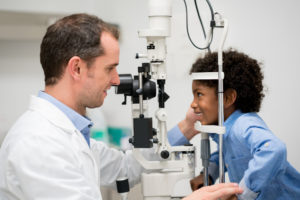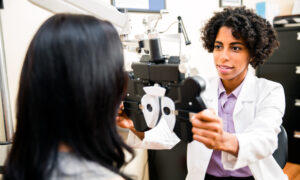October 1, 2020
By Dwight Akerman, OD, MBA, FAAO, FBCLA
 The risk of developing high myopia is relatively high among children with myopia onset at a young age. In contrast, each year of delay in the age of onset substantially reduces the chance of developing high myopia in adulthood.
The risk of developing high myopia is relatively high among children with myopia onset at a young age. In contrast, each year of delay in the age of onset substantially reduces the chance of developing high myopia in adulthood.
In this ongoing, population-based prospective cohort study involving 443 eligible candidates with a mean age at myopia onset of 11.7 years old, researchers from China estimated the risk of developing high myopia (spherical equivalent −6.00D or worse determined by cycloplegic refraction) in adulthood associated with a specific age at myopia onset from a data set with a 12-year annual follow-up.
Among the 443 eligible candidates, 54 (12.2 percent) developed high myopia in adulthood. The risk is substantially reduced to nearly 30 percent for onset at 9 years of age, 20 percent for onset at 10 years of age, and less than 5 percent for onset at 12 years or older.
Such results indicate that the high myopia risk is relatively high in children with myopia onset during the early school ages. Each year of delay in the age at onset substantially decreases the risk of developing high myopia in adulthood, demonstrating the value of identifying effective prevention strategies under investigation, such as increasing outdoor time to two hours per day or more.
Future studies with a larger sample size should be conducted to validate or modify the risks established. The results may not be generalizable to other populations as the risk of developing high myopia could depend on sample ethnicity, culture, and education intensity.
Abstract: Association of Age at Myopia Onset with Risk of High Myopia in Adulthood in a 12-Year Follow-up of a Chinese Cohort
Yin Hu, MD; Xiaohu Ding, MD, PhD; Xinxing Guo, MD, PhD; Yanxian Chen, MD, PhD; Jian Zhang, MSc; Mingguang He, MD, PhD
Importance: Early-onset myopia is well known to progress to high myopia in adulthood. However, no accurate estimation of how a specific age at myopia onset is associated with the probability of developing high myopia in adulthood is available, and a very-long-term follow-up study with data from annual visits is needed.
Objective: To estimate the risk of developing high myopia in adulthood associated with a specific age at myopia onset from a data set with a 12-year annual follow-up.
Design, Setting, and Participants: This ongoing, population-based prospective cohort study of twins was conducted in Guangzhou, China, on July 11, 2006. Data from baseline to August 31, 2018, were analyzed. The first-born twins completed follow-up until 17 years or older, and the 443 participants (after exclusions) who developed myopia were included in the analysis. Data were analyzed from September 1, 2018, to January 20, 2020.
Main Outcomes and Measures: Age at myopia onset was determined by prospective annual cycloplegic refractions (365 participants [82.4 percent]) or with a questionnaire. Refraction in adulthood was defined as the cycloplegic refraction measured at the last follow-up visit.
Results: Among the 443 eligible participants (247 [55.8 percent] female; mean [SD] age at myopia onset, 11.7 [2.0] years), 54 (12.2 percent) developed high myopia (spherical equivalent −6.00D or worse determined by cycloplegic refractions) in adulthood. Among participants with age at myopia onset of 7 or 8 years, 14 of 26 (53.9 percent; 95 percent CI, 33.4 percent-73.4 percent) developed high myopia in adulthood; among those with onset at 9 years of age, 12 of 37 (32.4 percent; 95 percent CI, 18.0 percent-49.8 percent); among those with onset at 10 years of age, 14 of 72 (19.4 percent; 95 percent CI, 11.1 percent-30.5 percent); among those with onset at 11 years of age, 11 of 78 (14.1 percent; 95 percent CI, 7.3 percent-23.8 percent); and among those with onset at 12 years or older, 3 of 230 (1.3 percent; 95 percent CI, 0.2 percent-3.8 percent). Results of multivariate logistic regression analysis suggested that the risk of developing high myopia in adulthood decreased significantly with delay in the age at myopia onset (odds ratio, 0.44; 95 percent CI, 0.36-0.55; P < .001), from greater than 50 percent for 7 or 8 years of age to approximately 30 percent for 9 years of age and 20 percent for 10 years of age.
Conclusions and Relevance: These findings suggest that the risk of high myopia is relatively high in children with myopia onset during the early school ages. Each year of delay in the age at onset substantially reduces the chance of developing high myopia in adulthood, highlighting the importance of identifying effective prevention strategies under investigation, such as increasing outdoor time.
Hu Y, Ding X, Guo X, et al. Association of age at myopia onset with risk of high myopia in adulthood in a 12-year follow-up of a Chinese cohort (2020). JAMA Ophthalmology.
DOI: 10.1001/jamaophthalmol.2020.3451













